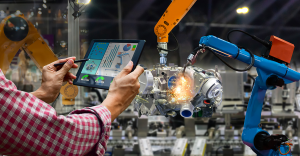At first glance, Next Generation Manufacturing Canada (NGEN) looks a lot like a fast-growing startup. It has attracted major investment, has doubled its staff and is putting all the various systems and processes in place to achieve its mission. The difference, however, is that NGEN is not trying to become the next great tech company — it’s on a path to help the entire manufacturing industry across the country to embrace the digital opportunities in front of them.
Governed by an independent board of governors and led by a team of executive managers, NGEN is a not-for-profit organization that is helping to establish an advanced manufacturing “supercluster” that will pair public funds and private investments in industry-led projects. This work can include everything from skills development and the adoption of technologies to creating new processes and products.
In what will be the first in an ongoing series of posts that explores the future of manufacturing in Canada, we recently spoke with NGEN Chief Strategy Officer David Fransen. This interview has been edited and condensed.
How would you best explain the scope and importance around NGEN’s goals to create an advanced manufacturing cluster?
If you think of manufacturing today, there are the classic kinds of organizations that we’re all familiar with — whether it’s automotive, aerospace or steel — that have made up the sector for years. In order to remain competitive, all those firms really need to adapt and adopt the leading-edge technologies. In addition to connecting new technologies with classical manufacturing, there’s also a need to champion the new technologies which in and of themselves represent things that could bring value to manufacturers. Robotics would be just one example where there’s an obvious fit.
What’s the risk of doing nothing — if NGEN weren’t leading the effort, for example?
Today, the industry is lagging. One of the reasons the government has decided to have a supercluster in the advanced manufacturing space is that the willingness of Canadian businesses to spend on R&D and to adopt new technologies in machinery and equipment tends to be at the average of the overall OECD level (of investment), but it’s falling.
In manufacturing, one is dependent on international markets — you have to be competitive with those other firms producing similar products. If we don’t play catchup and find champions to raise their heads above the others, it’s going to be harmful for the economy. The first effects are felt locally in some places, where companies lose contracts and therefore need to pare back their own internal resources. But it can get worse from there.
How will the programs and services you offer work in practice as your funding streams become operationalized?
In the case of our supercluster, we are requiring that each application reflect a partnership of at least three companies. We won’t be reviewing or funding applications that come from one company, or just two working together.
Take the example of an auto sector company trying to transform their manufacturing process. They see a problem that they’re trying to solve — and this could be a company with plants in Canada and abroad — and ordinarily they might seek a solution wherever they could find it. In this case, however, they’re using our funding and intermediary services to find Canada-based suppliers with whom they could partner. These might be tech companies that could help solve a problem, working together with smaller companies solving related problems, bringing all their resources — not just financial and human but IP — to the project and working in partnership.
In other cases there might be a growing firm in a technology space that is looking to expand in size with a new product and they’re looking for other small companies as partners. We help not only in the funding but in the networking with Canadian manufacturers and markets around the world.
Why do you think manufacturers here have not been more aggressive in adopting new technologies?
Part of it might be attributed to a cautious nature on the part of Canadian entrepreneurs. Part of it is also that there is some interesting research showing that Canadian manufacturing firms are profitable. They don’t set their sights on global dominance. To the extent they remain profitable, the incentive to take the bigger risk frequently isn’t there. I think we’re very quick to say that we are risk-averse. I think the generalization that we’re more risk-averse does apply, but it’s a bit more nuanced than that.
What’s a good way for manufacturers to see the potential technology could offer them?
Predictive maintenance is one of the most transformative examples. By applying machine learning to the data about a single production line, a manufacturer is able to do predictive maintenance rather than after-the-fact maintenance, which means it can have dramatic effects on costs and downtime. The moment you do that, you’re saving the company a lot of money. There are other areas where the application of new technology creates new business opportunities for organizations. The transformation can happen on the cost reduction side, but also in uncovering new service lines.
What’s the role of a company like Salesforce in contributing to an advanced manufacturing supercluster?
We look to Salesforce to become members of NGEN, to participate and work with us to provide support to the manufacturing sector. We have lots of leading companies who are approaching us and want to be part of the endeavor. Our role is to facilitate connections between excellent companies like Salesforce that have the strength of global networks and the expertise to create those networks — to create the handshake with smaller companies that are looking for that kind of support.

























